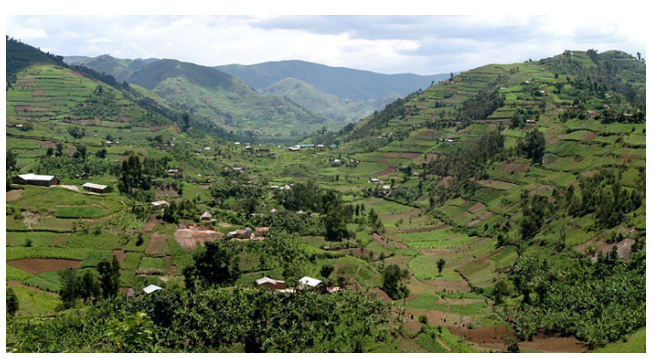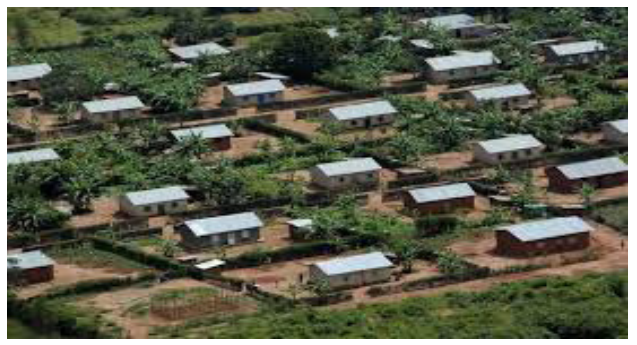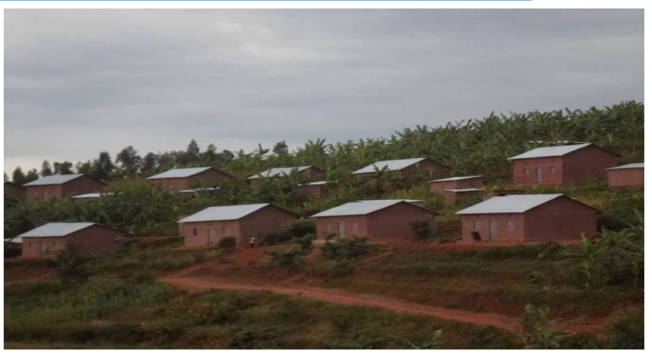UNIT 10:RURAL AND URBAN SETTLEMENT IN RWANDA
Key Unit competence: The student-teacher should be able to evaluate the impact of the rural and urban settlements on the sustainable development in Rwanda.
Introductory Activity
Discuss and answer the following questions:
1. Why is it necessary to have a home?
2. Identify the factors that influence the establishment of a home.
3. Draw a village where people live and display your picture in the class.
4. Discuss the advantages and disadvantages of rural and urban settlement.
10.1. Rural settlement
Learning activity 10.1
After making an observation of your local environment
1. Describe the characteristics of the area where you live.
2. Using the description that you have given, classify the area as urban or rural.
3. Give the type of settlement found in the area you have described.
A settlement refers to a place where people live. They build homes and form a community. In some areas a rural settlement is considered to be any settlement in the areas defined by the government as rural. This may include even rural towns. In some other areas, rural settlements do not include towns. Common types of rural settlements are villages, hamlets and farms.
Traditionally, rural settlements were associated with agriculture. In modern times, other types of rural communities have been developed.
10.1.1. Types of rural settlement
Clustered or nucleated rural settlement
This is a form of rural settlement where people live in houses that are grouped together in close proximity. These settlements are common in areas where extended families still hold a strong influence. In Rwanda, this type of settlement can be seen in parts of Rubavu, Muhanga, Musanze, Burera and Nyabihu districts.

Nucleated rural settlement
i. Dispersed, sparsed or scattered rural settlement
This is where people stay in houses that are far from each other. Most of the land is used for cultivation and grazing. This occurs in areas that have low populations. In Rwanda, this type of settlement is found in the Eastern Province where cattle rearing is a major activity. This settlement can also be found in areas near the National Park and other reserved areas like the Akagera and Birunga National Parks.

Scattered rural settlement
ii. Linear rural settlement
This is a type of settlement where people establish their homesteads in a linear form, usually along a road, a river, lake shores or a dyke.
This type of settlement is evident in most parts of Rwanda, for example along the Kigali-Huye road.

Linear rural settlement
iii. Planned rural settlement
This is a settlement that is established according to the standards put in place by the government. Such settlements are well-facilitated in terms of social facilities such as roads and health centres. It is a preferred type of settlement in areas faced with overpopulation. This is the common type of rural settlement in Rwanda. It was begun during the land reform program that came along with the introduction of the umudugudu.

Planned rural settlement
Application activity 10.1
Using a sketch diagram differentiate a linear to a dispersed settlement.
10.2. Problems and solutions associated with rural settlement in Rwanda
Learning activity 10.2
With reference to your own observation of any village:
1. Identify some of the problems associated with rural settlement in Rwanda and their solutions.
2. Find out Rwanda’s government policy towards rural settlement schemes in the country.
3. Discuss the importance of having rural settlement schemes in the country.
i. Some of the problems associated with rural settlements are discussed below:
• Poor transport and communication facilities: Rural areas in Rwanda are not well served with roads and communication systems. This has led to slow economic development and difficulties in the movement of people and goods.
• Low levels of education: The concentration of schools especially higher institutions of learning is very low in rural areas. Due to this, the quality of education remains very low.
• Poor medical care: The numbers of hospitals and other health facilities are very low. The few that are there have insufficient medical personnel. This translates to poor medical care and a high death rate.
• Easy spread of diseases: If there is disease outbreak or attack, many rural settlers tend to be affected. This may be due to poor hygiene and ignorance caused by illiteracy.
• Lack of social services: Some rural areas in Rwanda completely lack facilities such as piped water and electricity. This makes some of the areas to remain remote.
• Unemployment: There are fewer job opportunities in the rural areas.
• Limited markets: Due to low population in some areas, agricultural production exceeds the consumption levels. Since there is no market for the surplus, this leads to wastage of food and eventually poverty.
• Land and social conflicts: In the rural areas of Rwanda, there is always a perennial problem of insufficient land. Conflicts between neighbours and relatives over land and other resources like rivers, pasture land and boundaries are a common occurrence.
• Underutilization of resources: In most cases, rural settlements are under populated. The population available fails to properly utilise the available resources.
• Poverty and poor standards of living: The high levels of poverty have made the rural population to live under very poor living conditions. The houses in which they live in are small and are poorly constructed. The people cannot afford decent clothing, meals, healthcare and other essentials of life.
ii. Solutions to the problems of rural settlements
Some of the solutions to the problems of rural settlements include the following:
• Government housing and construction scheme: The government should construct better houses in the rural areas and make them affordable to all people. This will assist in solving the housing problem.
• Establishment of investments: Both local and foreign investors should be encouraged to venture into the untapped opportunities available in the rural areas of Rwanda. This will help to boost the economies of the rural areas and to improve the living standards of the population through employment opportunities.
• Development of the rural areas: Rural areas should be developed and provided with facilities to attract people to settle there. The facilities to be provided include electricity, piped water and social halls.
• Transport and communication facilities: Transport and communication networks should be established and developed in the rural areas. This will help to improve the economy of the rural areas and also to attract settlements.
• Social services: There should be improvements in the provision of social services to the rural population. Health centres should be constructed and more schools should be established in order to reduce the pressure being exerted onto the few existing ones.
• Implementation of regional balance by the government: The government should develop well balanced policies that will ensure equal development of all regions in the country.
• Mass education: The rural population needs to be educated on the disadvantages of migration to towns and on how to solve the social challenges that they face.
• Credit facilities: Financial and credit institutions should endeavour to economically empower the rural masses by giving them loans and credit facilities. This will help them to eradicate poverty.
• Diversification of the rural economy: The rural economy should be diversified through the establishment of other economic activities that will enable the farmers and the rural population in general to earn extra income.
iii. Government policy towards rural settlement
The Rwandan government has dealt with rural populations through the establishment of rural settlement schemes known as the imidugudu. This scheme was created as part of the land reform program in the country to promote equal sharing of land and to help the poor to build homes with the government’s assistance.
Reasons for establishment of Imidugudu settlement schemes in Rwanda
• To improve the living standards of the people: The Imidugudu settlements in Rwanda were created to improve the living standards of people especially the poor landless.
• To promote peace and unity among the Rwandese people: The establishment of the Imidugudu was part of the concerted effort by the government of Rwanda to restore peace and unity among the people of Rwanda.
• To utilise the natural resources in the country: The government of Rwanda decided to put people in the imidugudu schemes in order to find more land that could be used for other economic activities.
• To provide better social services to its citizens: The government of Rwanda decided to put its citizens in the imidugudu scheme in order to provide them with better social services.
• To provide general education and other social services: When people were put in the imidugudu, it became easy for the government to provide education to the poor thus increasing the literacy levels in the country.
• To implement the government’s policies and programs: The government of Rwanda put its citizens in the imidugudu so that it could be easy for it to implement its policies and programs on a population that is easy to reach out to.
• To settle thousands of refugees who returned after the genocide against the Tutsi. The government of Rwanda put people in the Imidugudu to settle the returned refugees from other countries.
• To find land for landless people in the country: The government wanted to provide land to the people who were homeless and landless.
Application activity 10.1.2
Describe the advantages and disadvantages of Imidugudu settlement.
10.3. Urban settlement in Rwanda
Learning activity 10.3
Mr.Bahati is a resident of Kabuga. Every day he takes a taxi to go at workplace in Kigali city. In the morning he gets at work late because of traffic jam in the roads of Kigali city. He cannot afford class house in the city. He preferred living in Kabuga because there are cheap houses compared to the city. But also less pollution even if there is frequent shortage of water.
1. Identify the problems faced by people who stay in the urban areas.
2. Suggest the solutions to the problems mentioned in the passage above.
10.3.1. Definition
An urban area is a built-up area such as a town or city. Urbanisation means an increase in the proportion of people living in urban areas compared to those living in the rural areas. As a country industrialises, the number of people living in urban areas tends to increase.
Rwanda has a high growth in population as well as development of urban centres. Many people are now found in cities and towns. The once small trading centres are now developing into municipal towns. The urban centres of Rwanda include the following:
Huye, Gicumbi, Rusizi ,Rubavu, Muhanga, Ngoma, Ruhango, Kigali , Nyanza, Musanze , Rwamagana, Nyamagabe , Kayonza, Karongi ,Nyamata, Nyagatare.
10.3.2. Factors favoring the growth of urban centres in Rwanda
There are several factors that have contributed to the development and growth of urban centres in Rwanda. Some of the factors are discussed below.
• Transport and communication: Transport and communication have facilitated the growth and development of towns. They facilitate trade and the development of other social facilities. Some of the examples of towns that have grown as a result of transport and communication include: Kigali, Musanze and Kayonza.
• Industrialization: Areas that have many industries usually turn out to be industrial towns. The employment opportunities available attract many people.
• Supportive government policies: The government through policy makers identifies areas that have to be developed into towns. The master plan for Kigali includes all areas around the city which are rural in nature but are now being developed into urban centres.
• Historical factors: This is a major factor that contributed a lot to the development and growth of Nyanza town. Historically, the town used to host the king’s palace. As a result, many people were attracted to the town where they settled and invested in.
• Strategic position: The location or position of a place in relation to major facilities contributes a lot to the growth of an urban area. Kigali City for example developed because of its location at the centre of the country.
• Social facilities: The presence of facilities such as schools and hospitals influence the development of urban centres since they attract many people.
• Trade and commerce: Areas which are associated with trading activities easily develop into urban centres. Such areas include Musanze, Kigali, Rubavu and Gicumbi. They all developed due to the convenience they offered to the business community.
• Power: This has contributed to the development and growth of some towns in Rwanda. The presence of electric power stations and other sources of energy such as methane gas play a great role in attracting various activities to areas. An example is the Bralirwa industry in Rubavu -Western Province.
10.3.3. Problems of the urban centres and their solutions
i. Problems of the urban centres of Rwanda Urban centres are mainly associated with the following problems:
• Unemployment caused by a high rural- urban migration of people.
• Environmental pollution due to poor waste disposal and industries.
• Deforestation that occurs due to the need for space for expansion and timber for building
• Decline in agriculture due to rural-urban migration.
• Congestion of people posing a risk of infections and the spread of other diseases.
• High rates of crime and other social ills that arise due to the large number of idle youths.
• Loss of culture that occurs because of mixing of people from different cultural backgrounds.
• Development of unplanned settlement because of low income earners of city dwellers but also massive incoming of rural people in city disturb the implementation of city housing plan.
ii. Solutions to the problems of urban centres
• Construction of sky scrapers in order to use less land and gain space for other activities.
• Recycling, treatment and proper disposal of industrial waste to avoid pollution of the environment.
• Strengthening the police force in order to fight the increase of crime.
• Developing transport systems in order to avoid traffic congestion.
• Construction of more industries to create more employment opportunities.
• Mass education on the danger of rural- urban migration in order to have fewer people in the urban areas and other people practicing agriculture in the rural areas.
• Extension of credit facilities by the government through banks and other financial institutions to enable people create jobs for themselves.
• Devolving essential services and institutions to the rural areas to contain rural-urban migration.
• Provision of decent and affordable housing to the people to contain the emergence of slums.
Application activity 10.3 1.
Evaluate the advantages and disadvantages of urbanization.
2. Suggest what should be done to solve the problem of slums in major urban areas.
Skills lab
Give advice to the people thinking that better life is found in urban areas
End unit assessment
1. Giving examples, discuss four types of rural settlements that are found in Rwanda.
2. a) Explain five factors that influence rural settlements in Rwanda.
b) Discuss three problems of rural settlements in Rwanda and give their solutions.
3. Explain five factors that have favoured urbanization in Rwanda..
4. Evaluate three positive and three negative effects of urban settlements in Rwanda.
